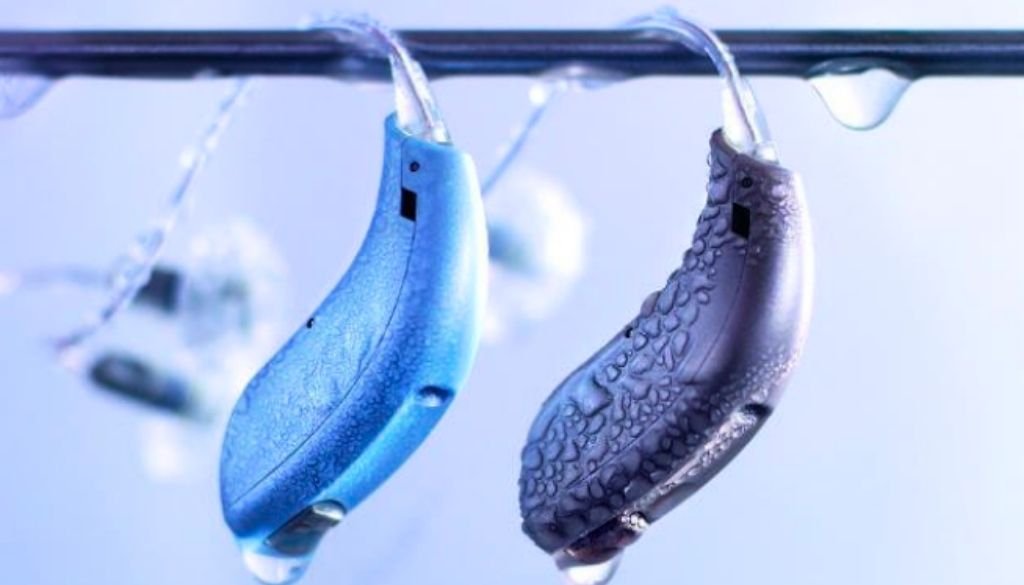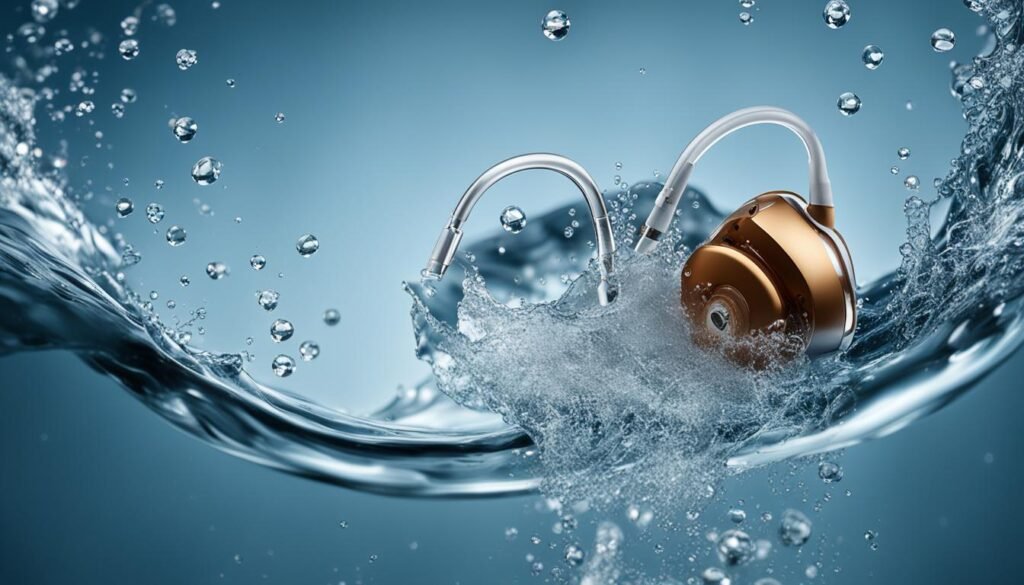What to Do if Rechargeable Hearing Aids Get Wet? This question worries many hearing aid users, as water damage can be a significant concern. If your rechargeable hearing aids become wet, knowing the proper steps to minimize potential harm is crucial. This comprehensive guide will explore the best practices for dealing with damp hearing aids.

From understanding the impact of water on these delicate devices to learning immediate drying techniques and preventive measures, this guide covers everything you need to safeguard your hearing aids. We’ll also discuss long-term care tips to maintain the functionality and prolong the life of your rechargeable hearing aids, ensuring they continue providing the auditory support you need daily.
So, let’s dive into what you need to do if your rechargeable hearing aids get wet:
Key Takeaways:
- Act promptly if your rechargeable hearing aids get wet to prevent further damage.
- Follow the steps outlined in the upcoming sections to handle different levels of water exposure.
- Understanding water resistance ratings and limitations of hearing aids is crucial for proper care.
- Preventive measures can help protect your hearing aids from moisture and water damage.
- If you experience persistent issues, seek professional assistance from your hearing care provider.
Understanding Water Resistance Ratings for Hearing Aids
When protecting your hearing aids from water damage, it’s essential to understand their water resistance ratings. Most modern hearing aids are designed with some level of water resistance, but it’s important to note that they are not entirely waterproof.
Hearing aids are assigned an IP (Ingress Protection) rating, indicating their protection level against dust, dirt, and water. The IP rating consists of two numbers: the first represents the level of protection against solid particles, and the second indicates the level of protection against water.
For example, the Oticon hearing aids have an IP68 rating, where six indicates they are dust-tight, and eight signifies that they can be submerged up to 1.5 meters for 30 minutes and continue to work. However, it’s important to note that even with a high IP rating, hearing aids should not be intentionally submerged.
Waterproof and water-resistant are terms often used interchangeably but have different meanings. Waterproof hearing aids offer the highest level of water protection and can withstand being submerged in water for extended periods. Water-resistant hearing aids, on the other hand, can handle occasional exposure to moisture, such as rain or sweat, but are not designed for prolonged water immersion.
Remember, water resistance does not guarantee complete protection against water damage. It’s essential to exercise caution and take appropriate measures to protect your hearing aids from water exposure, even if they have a high IP rating.
By understanding the water resistance ratings of your hearing aids, you can make informed decisions about their care and usage. Refer to the manufacturer’s guidelines and consult your hearing care provider for specific water exposure and maintenance recommendations.
Steps to Take if Your Hearing Aids Get Fully Submerged
Accidents happen, and if your hearing aids get fully submerged in water, it’s essential to act quickly to minimize damage and ensure their functionality. Follow these steps to handle fully immersed hearing aids properly:
- Remove the hearing aids from the water immediately: The longer they stay submerged, the higher the chances of water seeping into sensitive components.
- Turn off the hearing aids: If possible, switch off your hearing aids to prevent any electrical shorts or damage.
- Remove the batteries: Take out the batteries to prevent any further power supply to the device.
- Dry the hearing aids: Use a soft cloth or tissue to pat dry the hearing aids gently. Avoid using a hairdryer or other heat source, which may damage the internal components.
- Keep the hearing aids in a dry environment: Place the hearing aids in a dehumidifier or a sealed container with desiccant packs to remove any remaining moisture. Avoid using rice, as it may leave debris inside the device.
- Contact your hearing care provider: After drying the hearing aids, contact your hearing care provider for further assistance. They can conduct a thorough inspection, cleaning, and any necessary repairs to ensure the hearing aids are functioning optimally.
In some cases, fully submerged hearing aids may require professional attention to restore functionality. Remember, prevention is always better than cure, so it’s essential to avoid immersing your hearing aids in water whenever possible.
Dealing with a Splash of Water
Suppose your rechargeable hearing aids only get a splash of water, such as in a shower or rainstorm. In that case, taking immediate action is essential to prevent potential damage or malfunction. By following these simple steps, you can effectively dry your hearing aids and troubleshoot any issues that may arise.
Step 1: Remove the hearing aids from your ears
When you realize that your hearing aids have been splashed with water, carefully remove them from your ears. This will help prevent further moisture from entering the devices and reduce the risk of damage.
Step 2: Wipe away excess water
Gently wipe the surface of your hearing aids with a clean, dry cloth to remove any visible traces of water. Please pay attention to all openings, such as microphones and battery compartments, to ensure they are thoroughly dried.
Step 3: Allow the hearing aids to air dry
Place your hearing aids in a dry and well-ventilated area to allow them to air dry completely. Avoid using heat sources such as hairdryers or ovens, as excessive heat can damage the delicate components of your devices.
Step 4: Test your hearing aids
Once your hearing aids are fully dry, insert the batteries and perform a functional test to ensure they work correctly. If you notice any issues, such as distorted sound or reduced volume, consult your hearing care professional for further troubleshooting and assistance.

Following these steps, you can effectively handle a splash of water on your rechargeable hearing aids. Remember to act quickly, wipe away excess water, allow for thorough drying, and test the functionality of your devices. It is always recommended to consult with your hearing care professional if you encounter any persistent issues or concerns.
Handling Sand and Dirt on Hearing Aids
Accidents happen, and sometimes, your hearing aids may come into contact with sand or dirt. It’s essential to take immediate action to ensure the longevity and functionality of your devices. Here are some steps to follow if your hearing aids get sandy or dirty:
Remove Excess Sand or Dirt
- Gently brush off any visible sand or dirt particles from the surface of your hearing aids using a soft-bristle brush or a clean, dry cloth.
- Avoid using water or any cleaning agents at this stage, as moisture can further damage your hearing aids.
Clean the Hearing Aid Receiver Opening
The receiver opening is the hearing aid part that goes into your ear. It can quickly accumulate debris, especially when exposed to sand or dirt. To clean the receiver opening:
- Remove the earmold or dome from the receiver opening.
- Inspect the receiver opening for any visible sand or dirt particles.
- If you see any debris, carefully remove it with a wax pick or a soft-bristle brush.
- Once clean, reattach the earmold or dome securely.
- Consider Professional Cleaning
If you’re unsure about handling the cleaning, process yourself, or if your hearing aids require a more thorough cleaning, it’s best to seek professional assistance from your hearing care provider. They have the expertise and specialized tools to clean your hearing aids properly and ensure they are free from any sand or dirt particles.
Does cortex work for tinnitus? Explore our detailed analysis to understand how this treatment could potentially alleviate your symptoms.
Remember, regular cleaning and maintenance are vital for the optimal performance and longevity of your hearing aids. By taking these steps and seeking professional assistance, you can keep your devices in top condition and enjoy clear and uninterrupted sound.
Prevention and Additional Tips
Preventing water damage to your hearing aids is crucial for their long-term functionality and performance. Here are some additional tips to keep your devices safe from moisture:
- Use a hearing aid dehumidifier: Investing in a hearing aid dehumidifier can help remove excess moisture from your devices. These tiny devices usually contain desiccant beads that absorb water, keeping your hearing aids dry and free from damage.
- Avoid exposing your hearing aids to water: While most modern hearing aids have some water resistance, it’s always best to avoid exposing them to water whenever possible. Remove your hearing aids before swimming, showering, or participating in water activities.
- Store your hearing aids properly: When you’re not wearing your hearing aids, make sure to store them in a dry and safe place. Avoid leaving them in areas of high humidity, such as the bathroom or kitchen. Consider using a dedicated hearing aid storage case to protect them from moisture.
- Regularly clean and maintain your hearing aids: Proper cleaning and maintenance can go a long way in preventing water damage. Use a soft, dry cloth to wipe away any moisture or debris from your hearing aids regularly. Follow the manufacturer’s guidelines for cleaning and maintenance.
- Keep spare batteries and drying kits handy: Extra batteries are always good. In case your hearing aids do get wet, you can quickly remove the batteries and place them in the drying kit to remove any moisture, enhancing the chances of a full recovery.
Following these prevention tips and additional measures can significantly reduce the risk of water damage to your hearing aids. Remember, prevention is critical when protecting your investment and ensuring optimal performance for years.
Protecting Your Hearing Aids During Water Activities
If you frequently engage in water activities, such as swimming or water sports, it’s essential to take extra precautions to protect your hearing aids. Consider using specially designed waterproof covers or sleeves that provide additional protection against moisture. These covers can help prevent water intrusion and minimize the risk of device damage.
Seeking Professional Assistance
If you have followed the steps outlined in the previous sections and are still experiencing issues with your wet hearing aids, it may be time to seek professional assistance. Hearing aid repairs, professional cleaning, and troubleshooting are best left to experts with the knowledge and experience to handle these delicate devices.
Read Also: What to Do with Hearing Aids When Someone Dies
Contact your hearing care provider or an authorized hearing aid specialist to schedule an appointment. They can thoroughly dry and clean your hearing aids, ensuring moisture or debris is removed correctly. They can also conduct a detailed inspection to identify any potential damage or malfunction requiring repairs.
“Professional assistance is crucial when it comes to handling wet hearing aids. Hearing care providers have specialized tools and equipment to thoroughly clean and dry the devices, while also being able to diagnose any underlying issues that may have occurred as a result of water exposure.”
Benefits of Professional Assistance
- Expert knowledge and experience in handling delicate hearing aid components
- Specially designed cleaning and drying equipment
- Diagnosis of potential damage or malfunction
- Possible repairs or replacement of damaged parts
- Peace of mind knowing your hearing aids will be adequately restored to optimal condition.
Remember, attempting to repair or clean your wet hearing aids alone can further damage the devices and void any warranty you may have. It’s always best to leave it to the professionals trained and equipped to handle these situations.
Conclusion
Accidentally getting your rechargeable hearing aids wet can be stressful, but by following the proper steps for handling wet hearing aids, you can minimize damage and restore functionality. It’s essential to act quickly and remove the batteries from your hearing aids to prevent further damage. Once you’ve removed the batteries, thoroughly dry the devices using a soft cloth or towel. Avoid using heat sources like hairdryers, as excessive heat can damage the delicate components.
Remember, prevention is critical when it comes to protecting your hearing aids. Avoid wearing them when they are likely to get wet, such as swimming or showering. Invest in hearing aid dehumidifiers to remove excess moisture and store your devices in a safe and dry place when not in use.
Read Also: can viagra cause hearing loss.
Suppose you encounter persistent issues with your wet hearing aids or do not function properly after following the above steps. In that case, it’s always best to seek help from a hearing care professional. They can provide thorough drying, cleaning, and necessary repairs to restore your hearing aids to optimal condition. By taking proactive measures to protect and care for your hearing aids, you can enjoy the benefits of clear and uninterrupted sound for years to come.
Frequently Asked Questions
What should I do if my rechargeable hearing aids get wet?
If your rechargeable hearing aids get wet, you must immediately protect your device and ensure its functionality. Follow the steps outlined in the guide to handle wet hearing aids and prevent further damage properly.
Are all modern hearing aids water-resistant?
Most modern hearing aids are designed with water resistance in mind and are assigned an IP (Ingress Protection) rating. However, it’s important to note that even with a high IP rating, hearing aids are not completely waterproof and should not be intentionally submerged.
What should I do if my hearing aids get fully submerged in water?
If your hearing aids get fully submerged in water, such as in a pool or ocean, follow the steps outlined in the guide to increase the chances of salvaging and restoring functionality to your device.
What should I do if my hearing aids only get a splash of water?
If your hearing aids only get a splash of water, such as in a shower or rainstorm, you can follow the steps outlined in the guide to minimize damage and ensure the continued functionality of your device.
How should I handle sand or dirt on my hearing aids?
It’s important to avoid touching your hearing aids with sandy hands or letting them fall in the sand. If your hearing aids come into contact with sand or dirt, follow the steps outlined in the guide to clean and protect your device effectively.
How can I prevent water damage to my hearing aids?
The guide provides additional tips to prevent water damage to your hearing aids, such as using hearing aid dehumidifiers and taking proactive measures to protect your device from moisture.
What should I do if my wet hearing aids continue to have issues?
If you experience ongoing issues with your wet hearing aids or do not function properly after following the steps outlined in the guide, it’s best to seek professional assistance. Contact your hearing care provider for thorough drying, cleaning, and necessary repairs to restore your hearing aids to optimal condition.
How can I protect and care for my hearing aids?
Accidentally getting your rechargeable hearing aids wet can be a stressful situation. Still, by following the proper steps for handling wet hearing aids and taking proactive measures to protect and care for your device, you can minimize damage and enjoy the benefits of clear and uninterrupted sound.



